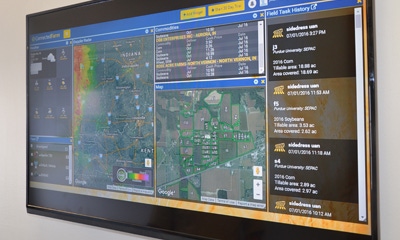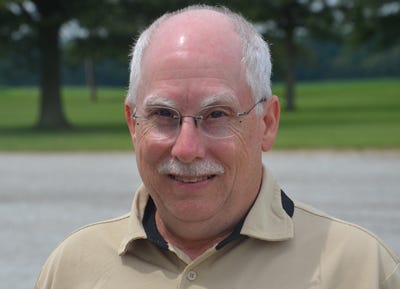
Don Biehle recently turned the reins of leadership at the Southeast Purdue Agricultural Center in Jennings County over to Joel Wahlman. As the only superintendent ever in SEPAC history, Biehle has seen nearly four decades of changes. Wahlman, at SEPAC as an assistant for nine years, has witnessed plenty of changes, too.
Biehle and Wahlman sat down in the SEPAC superintendent’s office and reflected on five major milestones since the research farm was founded in 1977.
1. No-till will work in southeast Indiana.

TECHNOLOGY IS THE FUTURE: This is the first thing you see when you walk into the offices at the Southeast Purdue Ag Center today. It’s Trimble’s Connected Farm display, which will someday show what’s going on in each part of the farm at any one time.
If there was anywhere people thought no-till would fail in the 1980s, it was on the flat, wet, gray soils of southeast Indiana, Biehle says. “Researchers started trials here, and after a few years, they discovered it was just the opposite,” he says. “No-till works extremely well here, especially no-till soybeans.”
Wahlman inherited a poster from a 1988 SEPAC field day that Biehle kept in his office for nearly 30 years to remember that discovery. After eight years of research, primarily by Don Griffith, a Purdue University Extension agronomist who is now retired, no-till corn after soybeans averaged nearly 8 bushels per acre better per year compared to plowing. No-till soybeans in 30-inch rows averaged over 3 bushels per acre better.
“The real surprise was in drilled soybeans,” Biehle emphasizes. “The eight-year average was nearly 12 bushel per acre higher than soybeans following plowing.”
Biehle smiles when remembering those early days. “The first year Griffith no-tilled soybeans, we had space, and he said he would include no-till drilled soybeans. His theory was that by field day, people could tell they wouldn’t work, and it would be the end of it!"

CLASSIC RESEARCH: Don Biehle says the numbers on this poster used at a 1988 SEPAC field day helped convince farmers that no-till would work where they thought it wasn’t possible.
The reverse happened. Not only did that classic research let the genie out of the bottle, unleashing no-till soybeans in southeast Indiana, but it also fueled the move to drilled, narrow-row soybeans statewide.
“By the time he retired, there wasn’t a bigger believer in no-tilled, narrow-row soybeans than Don Griffith,” Biehle says.
2. Drainage works on flat, gray soils.
One of the first things that happened at SEPAC was installation of tile. Conventional wisdom was that tiling wouldn't work there.
“People in the old days used clay tiles, and we installed plastic tile,” Biehle says. “During the first 10 years it became obvious that tiling improved yields. Since then, Eileen Kladivko of Purdue has continued to prove that tiling pays here.”
3. No-till and drainage together boosted yields even more.

MILESTONES MARKED: Don Biehle points to major milestones at SEPAC that have changed agriculture in the area, and sometimes around the state and country.
Once tillage was shifted to no-till on the tiled research field, yields improved even more. “I’m convinced that the earthworms are helping provide channels that help with drainage,” Biehle says.
Water infiltration has improved since the shift to no-till as well, Biehle observes. The farm also measures flow out of the tile. Several positive changes have occurred in the past few years, he says.
“Our goal is to tile more of the farm as we have resources to do so,” Wahlman says. “A tile plow that they can pull with their largest tractor, one less than 100 horsepower, and modern GPS technology will help make that possible."
4. Training and field days are common occurrences.
“We held countless field days and various kinds of training here for farmers and others over the years,” Biehle says. SEPAC became a meeting place when Purdue wanted to provide training on various topics.
“We’ve hosted soil judging contests here and much more,” he relates. “In 2015, SEPAC was one of the practice sites for teams competing in the state soil judging contest."
5. SEPAC is a place to train the trainers.
“We’ve seen a dramatic shift in who uses the farm for research over the years,” Biehle observes. The likes of Larry Bledsoe, Vic Lechtenberg, Bob Nielsen, Jim Camberato and Dave Mengel, all current or former Purdue researchers, have conducted research at SEPAC, just to name a few. Kladivko has been working on a large cover crop study at SEPAC for the past few years.
“What we’ve seen more recently is that a bigger share of the people actually doing research here are masters and doctorate students,” Biehle says. “They make the trip down from campus, do their work and return. We’ve gotten to know several of them over the past few years.”
Wahlman adds, “Whenever we see a current agronomist or researcher who once was a student here pictured in a magazine, we cut it out and put it on a bulletin board. We’ve posted quite a few recently. They are all over the country.”
About the Author(s)
You May Also Like




